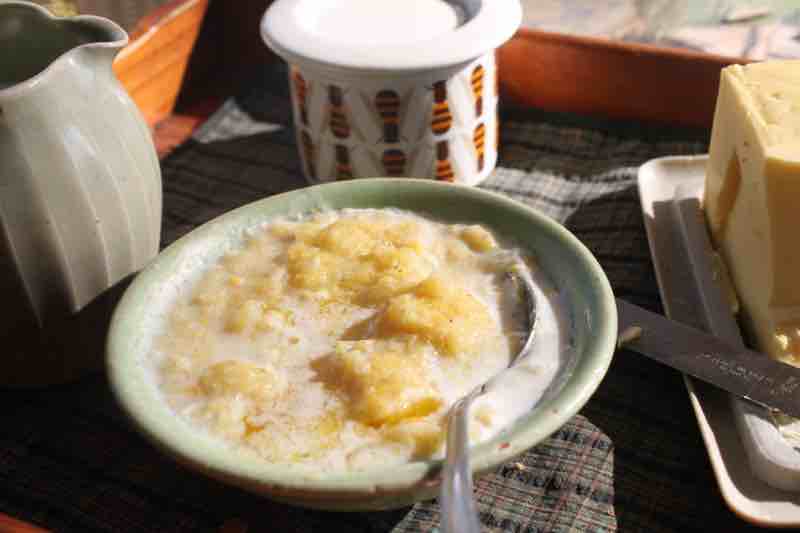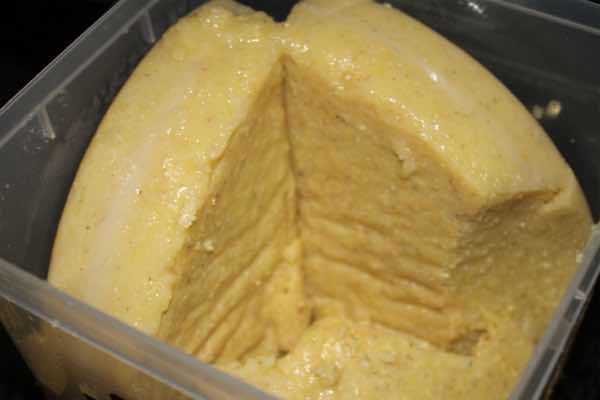- Bernard Preston homepage
- Corn
- Best Way to Cook Wholegrain Maizemeal
Best way to cook wholegrain maizemeal
The best way to cook wholegrain maizemeal takes some extra effort and a day's delay; it needs to cool and retrograde for at least 8 hours.
SUMMARY OF THE 4 PHASES
- Start soaking the meal 24 hours before you intend to eat it.
- Cook enough for several days; refrigerate the uneaten balance.
- Cool the porridge before eating it.
- Reheat enough porridge each morning with an added enriching liquid medium.
 Milk, cream and raw honey
Milk, cream and raw honeyBest way to cook wholegrain maizemeal
Whilst I'm totally committed to keeping it simple and slow food made fast, there are some things than simply cannot be rushed. And if it takes more time to produce a healthier, more palatable meal then we should consider whether it not worth the extra effort.
I have been cooking wholegrain maizemeal porridge for many years; it's definitely better to allow your breakfast to retrograde overnight.
Carbs and fats get bad press
Oscar Wilde the Irish writer once wrote, tongue in cheek, that fashion is something so bad that we have to change it every year; many a true word said in jest. It's just as valid of food as clothing.
First it was animal protein that was all bad, then it was fats; initially those that are saturated and now the polys. Around 10 years ago the blame for our poor health shifted to carbs.
It is a lot of nonsense of course, failing to appreciate the complexity of nutrition; unprocessed they are all good. Rather it's about what else you are eating and your general lifestyle too of course.
However let's acknowledge that the ultra-processing food industry is where much of the blame lies. Some of the polys are essential fatty acids; we would die without them. But these days so much is being added to baked goods for example that they make up a ten-times excessive amount; that is highly inflammatory.
And carbs are not all bad. It's French fries, baked potatoes from cold storage and ultraprocessed grains that are causing havoc with our health; raised serum glucose, inflamed organs and diseased blood vessels.
Wholegrain maizemeal and grains in generally are extremely healthy. Such that the cancer society actually recommends we consume one of them at every meal; but you won't find many in the average grocery store. They have a limited shelf-life once milled.
Best way to cook wholegrain maizemeal
The best way to cook wholegrain maizemeal is to assess how much your family will eat over a few days, prepare more than enough for one breakfast and allow it to cool overnight; then it "retrogrades."
Ingredients
- 2 cups say of wholemeal
- 2 cups of warm water
- 2tsp salt
- 6 cups boiling water
If you eat your wholegrain maizemeal porridge before it is cooled and then reheated, you will find it thin and less palatable; it may give you a bellyache.
Whilst whole grains in general are not fattening it could, if eaten immediately be threatening to those who are insulin resistant.
All starches and not just whole grains are better after cooling and then reheating.
Go for it
- Prepare the starter the morning ahead of when you want to eat it.
- Pour 2 cups of maizemeal into a large pot with the same amount of warm water; stir in the salt until it's smooth and place on the side.
- After at least 5 hours add 6 cups of boiling water, stirring regularly on medium-high heat initially until it starts bubbling; 45 minutes.
- Add extra water if it's too thick.
- Leave overnight on a slow woodstove or in a wonder-box.
- Chill for a couple hours early next morning. It will become thick and lumpy as the starch retrogrades.
- Then heat say a third with either a little hot water, milk or veggie stock; allow it to simmer gently for about five to ten minutes. Now it's perfect.
 Lined with polystyrene this homemade wonder-box keeps the porridge warm overnight.
Lined with polystyrene this homemade wonder-box keeps the porridge warm overnight.Option 1: Add just butter and milk
Enjoy your wholegrain grits as the Americans call it, pap in South Africa and polenta in Italy with a good dab of butter, extra salt to taste and milk if you choose.
Option 2: Butter, honey and milk
Again add that dab of butter and perhaps this time a spoonful of raw honey. With nearly 50% of adults being on the verge of diabetes we all need to avoid using sugar.
Natural honey has a low GI.
Option 3: Butter, milk and cream-cheese
This is to my mind the best way to cook and enjoy wholegrain maizemeal but it is dependent on you having good metabolic health; your blood glucose, lipid profile and weight are all within normal limits.
To the cold retrograded thick porridge again add a little milk and butter; bring to the boil and simmer as above. Now pour in a good dollop of cream, stirring thoroughly.
Finally in your bowl mix in a spoonful of cream-cheese; now you'll find your wholegrain maizemeal irresistible. The extra fat helps with the absorption of the beta-carotene.
Option 4: Spinach, onions and carrots
The Xhosa people in South Africa love to enrich their maizemeal porridge with vegetables; usually spinach, onion and carrots. It's actually very nice; and the potassium in the spinach will counterbalance the salt.
Option 5: veggie water
The thick retrograded maizemeal can also be brought back to the boil with vegetable water left over from cooking potatoes, greens or carrots for example; or a stock made from scraps.
First choice is yellow maize
Our first choice always is for yellow maize. The extra protein, less starch and beta-carotene are all so important; 20 children die every single day in South Africa from a vitamin A deficiency.
But white wholegrain maize is good too but it has less benefits and may be fattening; small helpings. It may also cause hypertension because of a very high sodium to potassium ratio; the yellow grain has a 60 times healthier profile.
It's unresearched as far as I know but I believe white maize raises blood pressure but the yellow gives protection against hypertension.
A change to yellow maizemeal would dramatically improve the health of South Africans; but that's a bridge too far for those who think it is pig food.
Why all that fat?
Fat should hold absolutely no fear for those enjoying a nourishing diet with plenty of salads, whole grains and legumes. There is debate mind you about that of animal origin; there you should follow your own guiding star.
At our green home we have no fear of butter and cream but could be mistaken. We are confident because serum glucose, blood pressure and cholesterol profiles are all in order; that's the joy of enjoying unprocessed foods, many from our own garden.
Many of the nutrients including beta-carotene in yellow maize are dependent on fat with the meal for absorption in the gut; so we are generous with butter and cream.
Retrogradation of wholegrain maizemeal
 Now add a little water or milk and simmer gently
Now add a little water or milk and simmer gentlyOf critical importance for all those suffering from abnormally raised blood glucose or obesity is an understanding of what happens to a starch when it is cooled. The molecules coil into a format that is more slowly digested; it is called retrogradation.
It forms what is known as a resistant starch; less is digested in the small intestine spiking the blood glucose and more reaches the colon to support the friendly bacteria known as the microbiome[1].
Mantecatura
There are some similarities between the best way to cook wholegrain maizemeal and preparing the perfect pasta known as mantecatura. First add the salt to the dry polenta, then the water and soak; boil for 45 minutes or so.
Allow the porridge to retrograde and then slowly pour in the liquid, milk or vegetable broth whilst reheating; the starch is released as a sort of natural glue giving it the creamy consistency that has such a lovely mouthfeel.
When browsing use right click and "Open Link in New Tab" or you may get a bad gateway signal.
Newsletter
Our newsletter is entitled "create a cyan zone" at your home, preserving both yourself and Mother Earth for future generations; and the family too, of course. We promise not to spam you with daily emails promoting various products. You may get an occasional nudge to buy one of my books.
Here are the back issues.
- Lifestyle and ideal body weight
- What are ultra-processed foods?
- Investing in long-term health
- Diseases from plastic exposure
- Intensive lifestyle management for obesity has limited value
- A world largely devoid of Parkinson's Disease
- The impact of friendly bacteria in the tum on the prevention of cancer
- There's a hole in the bucket
- Everyone is talking about weight loss drugs
- Pull the sweet tooth
- If you suffer from heartburn plant a susu
- Refined maize meal and stunting
- Should agriculture and industry get priority for water and electricity?
- Nature is calling
- Mill your own flour
- Bake your own sourdough bread
- Microplastics from our water
- Alternative types of water storage
- Wear your clothes out
- Comfort foods
- Create a bee-friendly environment
- Go to bed slightly hungry
- Keep bees
- Blue zone folk are religious
- Reduce plastic waste
- Family is important
- What can go in compost?
- Grow broad beans for longevity
- Harvest and store sunshine
- Blue zone exercise
- Harvest and store your rainwater
- Create a cyan zone at your home
Did you find this page interesting? How about forwarding it to a friendly book or food junkie? Better still, a social media tick would help.
- Bernard Preston homepage
- Corn
- Best Way to Cook Wholegrain Maizemeal
Address:
56 Groenekloof Rd,
Hilton, KZN
South Africa
Website:
https://www.bernard-preston.com